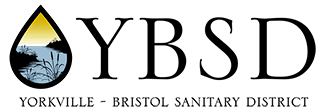About Us
 The Yorkville-Bristol Sanitary District (YBSD) is an independent municipal corporation under the provisions of the Illinois Sanitary District Act of 1917. The formation of the District was authorized by referendum at the elections of December 27, 1954, and confirmed by order of the County Court of Kendall, January 5, 1955. The YBSD provides wastewater transportation and treatment services for the City of Yorkville, Illinois the county seat of Kendall County. The District Trustees, R. Brent Ekwinski, Kurt Muth, and Mark A. Luettich, are stewards of the YBSD, and are very aware of the needs of the community.
The Yorkville-Bristol Sanitary District (YBSD) is an independent municipal corporation under the provisions of the Illinois Sanitary District Act of 1917. The formation of the District was authorized by referendum at the elections of December 27, 1954, and confirmed by order of the County Court of Kendall, January 5, 1955. The YBSD provides wastewater transportation and treatment services for the City of Yorkville, Illinois the county seat of Kendall County. The District Trustees, R. Brent Ekwinski, Kurt Muth, and Mark A. Luettich, are stewards of the YBSD, and are very aware of the needs of the community.
The Boundaries of the Sanitary District encompass an area greater than 10 square miles. The facility planning area of the District is 33.8 square miles, and the estimated planned ultimate area to be served is approximately 50 square miles. YBSD has one wastewater treatment facility that is designed to treat three million, six hundred twenty thousand (3,620,000) gallons of wastewater per day, or serve a population of thirty six thousand, two hundred (36,200) people. The present population equivalent (PE) is about 20,925.
About the Process
The Illinois Environmental Protection Agency (IEPA) requires a Class 1 certified operator to be available 24 hours a day for this size of facility. YBSD is managed and operated by 6 full time employees with 1 Class 1 certified employee. The treatment facility is an activated sludge process, without the use of primary sedimentation. The wastewater enters the plant via 14.3 miles of interceptor (large trunk lines) sewers, ranging from 12 inches to 42 inches in diameter.
Upon arriving at the plant the wastewater flows through medium screens to remove large materials such as rags and then the wastewater is pumped to fine screens for final removal of grit, grease, and detritus materials. Next, the wastewater is pumped directly into the aeration tanks (biological process) where aerobic bacteria absorb and adsorb the solids and break them down to a stable odorless product. The bacteria then form a floc that is sent to the settling basins (final clarifiers) where they settle out under quiescent conditions, and a clear supernatant (clear water) is carried out over weirs (troughs). The clear water then goes to an ultraviolet (UV) contact tank for disinfection, and aeration, then directly to the Fox River.
The excess solids that are produced by bacteria multiplication (binary fission) is wasted (pumped) to a Waste Activated Sludge (WAS) tank for aeration and storage. Portions of the WAS is thickened every weekday with a Gravity Belt Thickener (GBT). The thickened sludge is then sent to an Autothermic Thermophilic Aerobic Digester (ATAD). The ATAD process produces a high heat, and stabilizes the sludge to meet a Class “A” biosolids. After the digestion process is complete, the excess solids are sent to a Centrifuge for final dewatering. This final dried sludge is then taken to a landfill for disposal.
